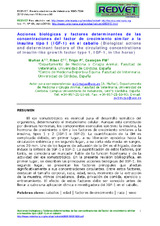Acciones biológicas y factores determinantes de las concentraciones del factor de crecimiento similar a la insulina tipo I (IGF-1) en el caballo
Biological actions and determinant factors of the circulating concentrations of insulin-like growth factor type 1, IGF-1, in the horse

Ver/
Autor
Muñoz, A.
Riber, C.
Trigo, Pablo
Castejón Montijano, F.
Editor
Veterinaria.orgFecha
2010Materia
HorsesCaballos
Edad
Age
Growth factors
Factores de crecimiento
Raza
Sexo
Breed
Gender
METS:
Mostrar el registro METSPREMIS:
Mostrar el registro PREMISMetadatos
Mostrar el registro completo del ítemResumen
El eje somatotrópico es esencial para el desarrollo somático del
organismo, determinando el metabolismo celular. Aunque está constituido
por diversas hormonas, los componentes esenciales son tres: la insulina, la
hormona de crecimiento o GH y los factores de crecimiento similares a la
insulina, tipos 1 y 2 (IGF-1 e IGF-2). La cuantificación de la GH es
complicada debido, en primer lugar, a su liberación episódica hacia la
circulación sistémica y en segundo lugar, a su corta vida media en sangre,
unos 20 min. Uno de los lugares de actuación de la GH es el hígado, donde
induce la síntesis de IGF-1 e IGF-2. La cuantificación de estos factores, por
tanto, se considera un marcador fiable de la función hipofisaria y de la
actividad del eje somatotrópico. En la presente revisión bibliográfica, en
primer lugar, se describen las principales acciones biológicas del IGF-1. En
segundo lugar, se presentan los factores principales que afectan
significativamente a sus concentraciones circulantes. Entre estos factores,
destacan el tamaño corporal, raza, edad, sexo, momento de la extracción
de la muestra, ritmos circadianos, dieta, privación de comida, ejercicio y
entrenamiento. El efecto de estos factores debe ser conocido antes de
llevar a cabo una aplicación clínica e investigadora del IGF-1 en el caballo The somatotropic axis is pivotal for somatic development and cell metabolism.
Although it is composed by several hormones, the most important components are
three: insulin, growth hormone or GH and insulin-like growth factors type 1 and 2 (IGF-
1 and IGF-2). The measurement of GH is difficult and inaccurate, because two main
reasons: firstly, the GH hormone is released in an episodic way and secondly, its
blood half-life is short, about 20 min. The GH hormone has significant actions on the
liver, inducing the synthesis of IGF-1 and IGF-2. The measurement of these factors,
therefore, is considered a reliable marker of the activity of the hypophysis and the
somatotropic axis. In the present review, firstly, we will describe the main biological
actions of the IGF-1 and secondly, we will define the main factors that could
significantly influence the circulating concentrations of IGF-1. Among these factors, the
most important are body size, breed, age, gender, time of blood extraction, circadian
rhythms, diet, food privation, exercise and training. The effect of these factors should
be assessed prior to extended clinical and research use of IGF-1 in horses
